Lifting body tuned for passive re-entry
a technology for lifting bodies and re-entry vehicles, applied in the field of re-entry vehicles, can solve the problems of significant control problems, significant friction, drag and other aerodynamic forces, and generate tremendous heat, and achieve substantial cross-range and/or down-range descent path control, reduce acceleration, and reduce the effect of propellant requirements and risks to equipment and missions
- Summary
- Abstract
- Description
- Claims
- Application Information
AI Technical Summary
Benefits of technology
Problems solved by technology
Method used
Image
Examples
Embodiment Construction
[0031] In the following description, the invention is set forth with respect to specific re-entry vehicle configurations that provide for passive re-entry control for a lifting body re-entry vehicle. It will be appreciated that these particular configurations were achieved by taking a proposed vehicle design, developed based on a variety of mission considerations, and tuning the design, in accordance with certain principles described below, to achieve the desired level of passive re-entry control. Accordingly, it will be appreciated that other designs may be developed in accordance with the present invention. The following description, therefore, should be understood as exemplifying the invention and not by way of limitation.
[0032] The following description begins by setting forth the principles which have been found, surprisingly, to allow for passive re-entry control by a high performance re-entry vehicle. Thereafter, the description includes a generalized discussion of a re-entr...
PUM
 Login to View More
Login to View More Abstract
Description
Claims
Application Information
 Login to View More
Login to View More - R&D
- Intellectual Property
- Life Sciences
- Materials
- Tech Scout
- Unparalleled Data Quality
- Higher Quality Content
- 60% Fewer Hallucinations
Browse by: Latest US Patents, China's latest patents, Technical Efficacy Thesaurus, Application Domain, Technology Topic, Popular Technical Reports.
© 2025 PatSnap. All rights reserved.Legal|Privacy policy|Modern Slavery Act Transparency Statement|Sitemap|About US| Contact US: help@patsnap.com



